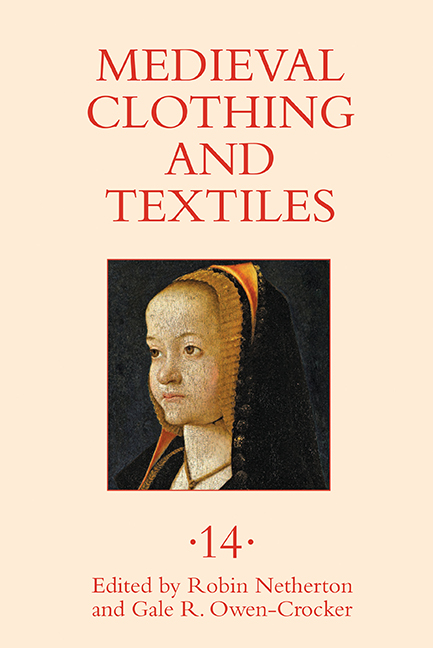Book contents
- Frontmatter
- Contents
- Illustrations page
- Tables
- Contributors
- Preface
- 1 Multicultural Clothing in Sixth-Century Ravenna
- 2 Byzantine and Oriental Silks in Denmark, 800–1200
- 3 The Bliaut: An Examination of the Evidence in French Literary Sources
- 4 Eyebrows, Hairlines, and “Hairs Less in Sight”: Female Depilation in Late Medieval Europe
- 5 Lexical Exchange with Italian in the Textile and Wool Trades in the Thirteenth to Fifteenth Centuries
- 6 Hidden in Plain Black: The Secrets of the French Hood
- Recent Books of Interest
- Contents of Previous Volumes
3 - The Bliaut: An Examination of the Evidence in French Literary Sources
Published online by Cambridge University Press: 13 July 2019
- Frontmatter
- Contents
- Illustrations page
- Tables
- Contributors
- Preface
- 1 Multicultural Clothing in Sixth-Century Ravenna
- 2 Byzantine and Oriental Silks in Denmark, 800–1200
- 3 The Bliaut: An Examination of the Evidence in French Literary Sources
- 4 Eyebrows, Hairlines, and “Hairs Less in Sight”: Female Depilation in Late Medieval Europe
- 5 Lexical Exchange with Italian in the Textile and Wool Trades in the Thirteenth to Fifteenth Centuries
- 6 Hidden in Plain Black: The Secrets of the French Hood
- Recent Books of Interest
- Contents of Previous Volumes
Summary
The term bliaut appeared suddenly in costume history in 1874 with the publication of the third volume of Eugène Viollet-le-Duc's Dictionnaire Raisonné du Mobilier Français. Not only did Viollet-le-Duc use the Old French term that we find in literary works dating from the twelfth through the early thirteenth centuries to discuss the sartorial practices of that age, but he also firmly identified the bliaut as the garment worn by the subjects of the statuary on the Royal Portal of Notre-Dame de Chartres. These statues, which are attenuated to fit on the narrow columns of the portal, depict Old Testament figures, both male and female, in elongated proportions. Their attire is depicted as highly ornamented and appears to fall into narrow elaborate pleats, even on garments worn under the outer gown; this pleating is primarily vertical, except for the pleats around some figures’ waists and wrists, where it runs laterally across the body. A year later Jules Quicherat repeated this identification in his Histoire du Costume en France. Both Viollet-le-Duc and Quicherat identified the dress seen in other statues and visual sources as bliauts, but it has been the association of the term with the Chartres statues that would become the best known and the most often repeated.
Viollet-le-Duc was innovative in that he sought out evidence for garment terms in Old French literary texts contemporary to the period, and Quicherat continued this practice. It is for this reason that the term bliaut emerges in such an abrupt manner in costume history. The term had not, and indeed could not have, made its way into earlier costume histories, simply because very few medieval manuscripts containing literary texts had been edited and published before the 1830s. The term bliaut had fallen into disuse and out of memory for all but etymologists and philologists, and it would be these scholars of old words and old texts who began the process of editing manuscripts for publication. For costume historians to cite literary sources before these editions existed, they would have had to read the texts of manuscripts, none of which were indexed, instead of consulting manuscripts simply to examine the illuminations. The illuminations themselves would have shed no light on garments of the twelfth century because the extant manuscripts of twelfth-century literature date to later centuries and therefore depict later clothing styles.
- Type
- Chapter
- Information
- Medieval Clothing and TextilesVolume 14, pp. 61 - 80Publisher: Boydell & BrewerPrint publication year: 2018

